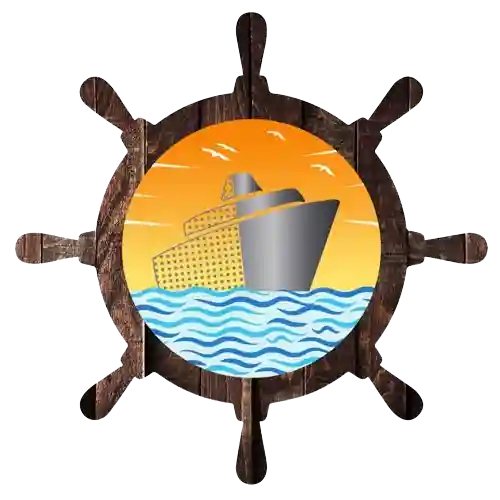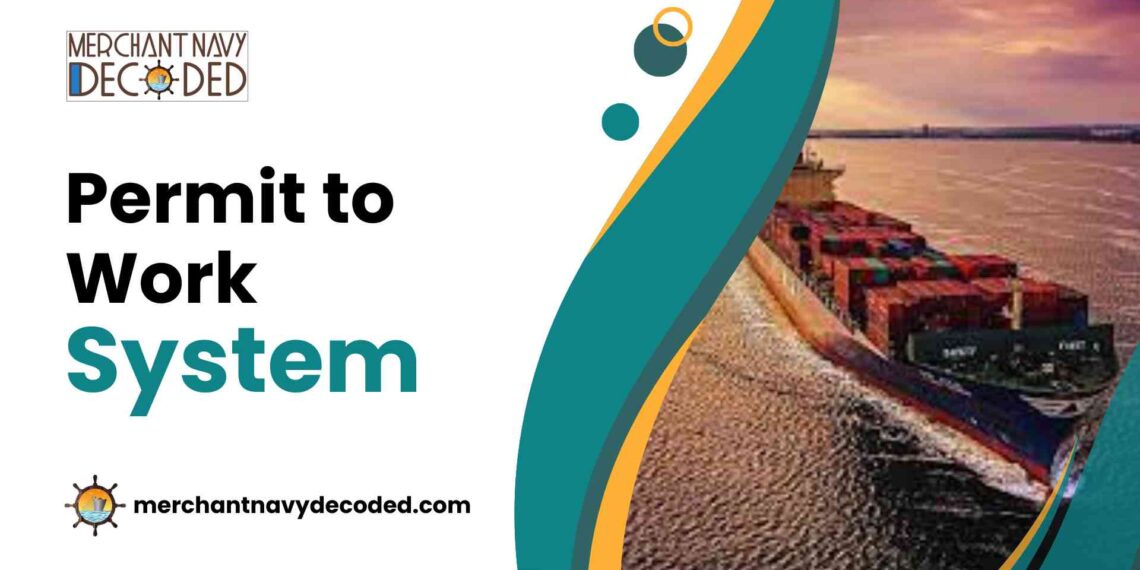Permit to Work System
1. What is the Work Permit System?
Permit-to-work system is a formalized process used by companies to manage and control high-risk activities to ensure that there is no harm to the health and safety of the workers. A permit-to-work system is an essential part of the risk assessment system as it finds out the different health and safety hazards possessed by the activities on board a vessel.
Permit to work system is a formal authorized system for controlling high-risk tasks. It is a system of work that contains predefined safety procedures. Permit to work system does not make the work safe rather it contributes to the safe working on board the vessel.
To get more such information regarding the deck side of a ship like ship stability, ship construction, colregs, etc visit our DECK DREAMER package.
2. Importance of the work permit system
The importance of the work permit system can be defined in a way that it does not provide any type of safety or security to the personnel working on board but it guides or provides instructions regarding the commencement of work, types of equipment to be used while doing a particular work, PPE to be worn, etc. Hence work permit system is very crucial to be followed while doing any work that engages any type of danger to the vessel as well as the lives and properties on board.
3. Key Element of Work Permit
Permit to work is a formal document used on board that has to be filled by the personnel performing that task and it has to be signed by the authorized person or the officer on watch.
A permit to work includes crucial details filled out by the person performing the task i.e.
3.1 Job Detail
A person/worker who will perform some work has to describe the work like fixing a machine, working in an enclosed area, working on Monkey Island, etc.
3.2 Location
Specify the area where exactly you are going to do work, for example, if you are going to perform work on the Radar then you have to mention it so that OOW knows that someone is on the radar and hence he will ensure nobody should operate until work is done.
3.3 Date and Time
Mention the date and time when you plan to start and finish the work.
3.4 Tools and Equipment
Specify the equipment that you will use, ensuring that they are appropriate for the job.
3.5 Safety measures
You will list down the safety measures you will take to avoid the accidents involved while performing the work.
3.6 Supervision
There should always be a person supervising or assisting you, you have to mention who is supervising or assisting you.
3.7 Permit Issuer
Specify the authorizing personnel who are permitting you to perform work (usually the top four of the ship).
3.8 Signature
Sign the permit to ensure that you have understood the work and the safety instructions mentioned on the permit and do take the sign of authorizing authorities.
3.9 Validity of permit
The permit is valid for a specified duration, and it should be noted that the maximum permissible validity of any permit must not exceed 24 hours.
4. Types of Work Permits
There are mainly 10 types of permits to work:
4.1 Hot Work Permit
Hot work permits are the document required to be carried out before carrying out any type of hot work on board. Hot work refers to work involving open flames like welding, cutting, smothering, and other activities generating heat. The purpose of hot work is to assess the risks associated with hot work.

4.2 Enclosed Space Permit
These are required when entering into an enclosed space, describing the risk involved while entering an enclosed area. The hazard in enclosed space entry is the deficiency of the oxygen content in the area. Deficiency of oxygen can lead to the formation of hot spots and can affect the human body differently.

4.3 Cold Work Permit
These are required while working in an environment where the temperature is significantly lower than normal or working in a hazardous area, which does not create a source of ignition. Essential tasks such as connecting and disconnecting a pipeline, removing and fitting the valve, etc.
4.4 Working Aloft Permit
These are required for work involving working at a height of 1.8m or above the deck level that involves a risk of falling overside into the water, including working into the tank, working alongside an open hatch, or other openings.

4.5 Work on Deck During Adverse Weather
These are required when working on deck in adverse or bad weather conditions encountering extreme wind force and heavy rolling and pitching.
4.6 Electric Work Permit
This is the document required when carrying out electric work or on equipment where there is the risk of electric shock. Examples of such work include maintenance, installations, repair, or modification of electric systems and equipment.

4.7 High Voltage Work Permit
This is the document that has to be filled out before carrying out any type of high-voltage work. High-voltage work refers to the work on equipment or systems with a voltage of 1000 volts or higher.
4.8 Work on pressurized pipelines/vessel Permits
These are required while working on pipelines and vessels that are under pressure such as pneumatic lines, steam lines, hot water lines, boilers, compressors, etc.
4.9 Underwater Operation
When carrying out any underwater operation involving a diver, this permit is required with the checklist. This permit contains all the instructions and risk assessments that have to be followed while performing any underwater operation.

5. Roles and Responsibilities
5.1 Approver
An approver is a person on board who is an approving authority on board. An approver is responsible for the work and the safety of the individual who is involved in doing a certain task. Master on board is mainly a designated approving board authority, for certain tasks that require a high level of control like hot work, working aloft, etc.
5.2 Responsible Officer
A responsible officer is a person who is designated by the Master ( approver ) and authorized by the master to make all decisions regarding the task, having the necessary information and experience regarding the work.
The responsible person varies as per the requirement of the task and is defined as per the permit to work.
The responsible officer should ensure that:-
- Issuance and closure of permits.
- Insurance of all the safety measures and equipment required during the task.
5.3 Isolating Authorities
A person is responsible for completing the isolation required for the task.
Mainly Electric Officer or Chief Officer is responsible for isolating the electrical equipment.
In other cases, either the Chief Officer, Chief Engineer, or 2nd Engineer is responsible.
5.4 Task Performer
A trained person is designated to carry out the work covered by the permit to work.
Task performers are responsible for carrying out the task in a safe manner keeping in mind all the hazards associated with the task, and taking all necessary precautions as per permit to work.
In any case, the task performer and responsible officer cannot be the same person.
5.5 Team Leader
A person who leads/supervises the team or task performer. Team leaders have to manage all the task performers and have to manage the task they are doing at the same time for the safety of every individual involved.
In the case of the single person performing the task, then the team leader and task performer are the same person.
5.6 Fire watch/Attender
A suitably trained person who is designated to maintain a watch on the task, and a person whether they are doing it correctly and with full precautionary measures.
For example, maintaining a record as required.
Fire watch and task performer cannot be the same person.
6. Procedure of Work Permit
Let’s try to understand the procedure of the permit-to-work system:-
- First, we have to discuss the task. The risk involved in that task, the equipment that is appropriate for the task, etc are to be discussed.
- We have to ensure that the area where we will perform the task is mentioned on the permit to work.
- We have to specify the duration of a task.
- Discuss if any type of isolation is required during the task.
- A responsible officer along with the team leader, and task performer must ensure the completion of all preparation checks
- The task performer must countersign the permit and ensure that the permit is approved by the master.
- After getting approval from the master the permit to work is issued by the responsible officer.
- The responsible officer and team leader have to do a periodic check at certain intervals during the task.
- After completion of the work make sure that you have properly secured the area where you were working
- You should make sure that after completing the work or if the duration of the permit is completed it should be canceled by the responsible person.
7. Frequently Asked Questions
Q1 What is the duration of the work permit?
Ans. The maximum duration or validity of the permit to work does not exceed more than 24 hours.
Q2 Who approves a work permit?
Ans. The master or Chief Engineer generally approves a permit.
Q3 What are the benefits of a work permit?
Ans. The benefit of a permit to work is to contribute to the safety of a task performer by mentioning the procedure and equipment required for the tasks.
Q4 Can a responsible person and task performer be the same person?
Ans. No, a responsible person and a task performer cannot be the same person.
Q5 What equipment is required as per the work permit?
Ans. Equipment appropriate for the work as per work permit is required.
Q6 What are some examples of hot work?
Ans. Welding, cutting, grinding, etc are examples of hot work.
Disclaimer :- The opinions expressed in this article belong solely to the author and may not necessarily reflect those of Merchant Navy Decoded. We cannot guarantee the accuracy of the information provided and disclaim any responsibility for it. Data and visuals used are sourced from publicly available information and may not be authenticated by any regulatory body. Reviews and comments appearing on our blogs represent the opinions of individuals and do not necessarily reflect the views of Merchant Navy Decoded. We are not responsible for any loss or damage resulting from reliance on these reviews or comments.
Reproduction, copying, sharing, or use of the article or images in any form is strictly prohibited without prior permission from both the author and Merchant Navy Decoded.



